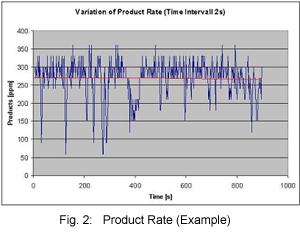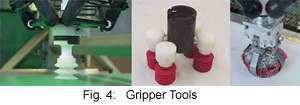Robotics
in Packaging Application Developments and Success Factors
Dipl.-Ing. (FH) Frank-Peter Kirgis ,
MBA
SIG
Pack Systems AG , Beringen, Switzerland
(as presented at the Robots
2004 Conference , June 9 and 10, 2004)
(Posted 06/01/2004)
The
use of robots in packaging
During the past ten years, the use of robotics in the
area of food packaging did increase and new, exciting
applications come up very frequently. The standard uses
for robots in the food manufacturing environment are
in packaging—such as for top loading wrapped articles
into cartons, or case-packing, and palletizing, as well
as high-speed pick and place applications - and will
continue to grow. Robots have become simpler to use,
cost less and the technology has evolved to apply to
a much wider range of applications today. From decorating
machines and extremely reliable Quality Control functions
in the process area, to counter mold feeding into wrappers
and mold stacking/retrieval systems, robots are showing
up everywhere. Developments in special end-of-arm-tooling,
vision technology and the controller technology expand
the things that robots can do. Not only has robotics
become accepted, but given the real world of operating
cost pressures, it’s a must that you at least know enough
about what’s out there to decide if it makes sense for
your needs. If you are not already using some kind of
robotics in your factory, you probably ought to be learning
all you can about them and looking for opportunities
to use them as part of your company’s manufacturing
strategy.
Flexibility
rules
Up until now coping
with wrapping a new product has been a real challenge
for the packaging industry. Whereas humans are able
to quickly adapt to pack different products, programming
machinery to have the same flexibility is another matter.
Modifying machinery to package different products was
a challenge too far for many until recently. Now, those
manufacturers, who have been quick to adopt and install
new packaging systems, are stealing an edge over their
rivals. This is made possible by specially designed
machinery and developments in software. Good packaging
companies also provide training to make adoption of
new technology straightforward and trouble free. Changeover
is especially quick and convenient when the entire packaging
process comprises one integrated system.

The deployment of robots in packaging lines is an area
where technology is quickening the pace and making human
hands redundant. Also, unlike humans, robots do not
suffer from repetitive strain, fatigue, boredom or any
of the related illnesses or conditions these provoke.
Establishing the need for robots in packaging lines,
however, requires consideration. First, the investment
needs to be cost justified, and then the system must
be modeled to make the most of the capabilities of robots.
When
it comes to the packaging of products, robots generally
fit into three main categories: pick and place applications
(where the goods are packed into trays or secondary
packages), feed placement (where products are prearranged
on a conveyer to ease future packaging) and palletizing
(pallet loading and unloading).
Indeed,
robots often replace human workers, which is why their
acceptance is often a subject of negotiation. However,
robots do present a strong case of their own and this
is why we are seeing more and more getting to work in
food industry.
Incidences
of strain industries and lost time in the baking industry
are a motivator for many companies to seriously consider
the role of the robot. As the USA, UK, and elsewhere
in Europe become more litigious, the costs against claims
against businesses from workers suffering workplace
related injuries will rise.
Consistency
is key
The
most obvious benefits associated with the installation
of robots in a packaging environment are:
- Labor
savings
- Reduced
sickness
- Overcoming
potential and existing labor shortages
- Increase
of production through higher efficiency
- Less
scrap
- Better
product quality
 Perhaps less obvious are the savings linked to a reduced head
count such as a reduction in cafeteria facilities, staff
recruitment and training costs, National Insurance contributions
and even the number of parking spaces required. Perhaps less obvious are the savings linked to a reduced head
count such as a reduction in cafeteria facilities, staff
recruitment and training costs, National Insurance contributions
and even the number of parking spaces required.
For
the packaging of food items, where speed, consistency
or high levels of repetition are concerned, the robot
almost always wins over humans in terms of efficiency.
But again, when it comes to new products within a packaging
line, humans are more adept at coping with more complex
tasks. As tasks become more complicated robots have
to increase in sophistication. As trends move to greater
product and packaging variety, modern robotic systems,
like their accompanying machinery, have also had to
become more flexible.
In
order to get the most out of robots, several factors
need to be considered. It is vital to attain:
- Highest
line performance
- Highest
robot performance
- Highest
efficiency (minimum overflow)
- Low
robot load (for the highest acceleration and speed)
- High
reliability
- High
redundancy (i.e. the ability to keep the line running
in the event of a robot stopping)
 The number of products in flow should equal the required number
of robots to fill all the trays. Efficiency is the name
of the game and the number of packed products should
always be maximized. Improvement in efficiency can be
brought about by adjusting the product belt speed to
optimise it in line with the robot performance. The number of products in flow should equal the required number
of robots to fill all the trays. Efficiency is the name
of the game and the number of packed products should
always be maximized. Improvement in efficiency can be
brought about by adjusting the product belt speed to
optimise it in line with the robot performance.
Apart
from the product feed, line configuration and belt speeds;
the positioning of the robot (see Fig. 3) is critical
to attain the highest efficiency. A well-defined work
area of each robot will stop them encroaching into the
picking area of another.
Vision
and Tooling are critical factors of success
Robots are equipped with intelligent vision systems.
This ensures that wherever products are placed on the
belt the robot is able to pick them up, so that wastage
is minimal.
 The grippers and vacuum tools (see Fig. 4) used by these robots
have also been further developed and good packaging
companies will offer a selection of these. For
example, the airflow vacuum tool is ideal for handling
goods with damageable surfaces because it can pick up
products without touching them. The Suction Cup is also
ideal for handling many kinds of products, especially
those with an uneven surface such as biscuits and frozen
pizzas. This sucks the product to the vacuum gripper
and holds it by using pressure difference, which allows
for fast pick up. Finger grippers are best used for
products that cannot be handled by suction, such as
cakes with loose particles on top. All gripper and suction
tools should be easy to clean, quick to be changed over
and made from materials suitable for the application. The grippers and vacuum tools (see Fig. 4) used by these robots
have also been further developed and good packaging
companies will offer a selection of these. For
example, the airflow vacuum tool is ideal for handling
goods with damageable surfaces because it can pick up
products without touching them. The Suction Cup is also
ideal for handling many kinds of products, especially
those with an uneven surface such as biscuits and frozen
pizzas. This sucks the product to the vacuum gripper
and holds it by using pressure difference, which allows
for fast pick up. Finger grippers are best used for
products that cannot be handled by suction, such as
cakes with loose particles on top. All gripper and suction
tools should be easy to clean, quick to be changed over
and made from materials suitable for the application.
In
conclusion
In summary, once the case for the robot has
been analyzed, it is important to address the economics
in the process. Measured against human costs, this may
be justified, but once line efficiency has been considered,
payback may not just come from reduced costs, but also
from increased productivity, efficiency and quality.
Perhaps the major advantage is the high level of flexibility
offered by robotics today. Slight alterations can be
made to the robot, so that it is able to cater for a
new product in a matter of minutes, without the use
of tools.
Technology is helping to create better cakes, pizzas,
rolls, candies and all other kinds to food items, which
reach the supermarket shelves quicker and consequently
leave that shelf quicker. Food manufacturers should
not to hold back, but embrace the packaging technology
offered today. They will then sit back and reap
the benefits.
|
